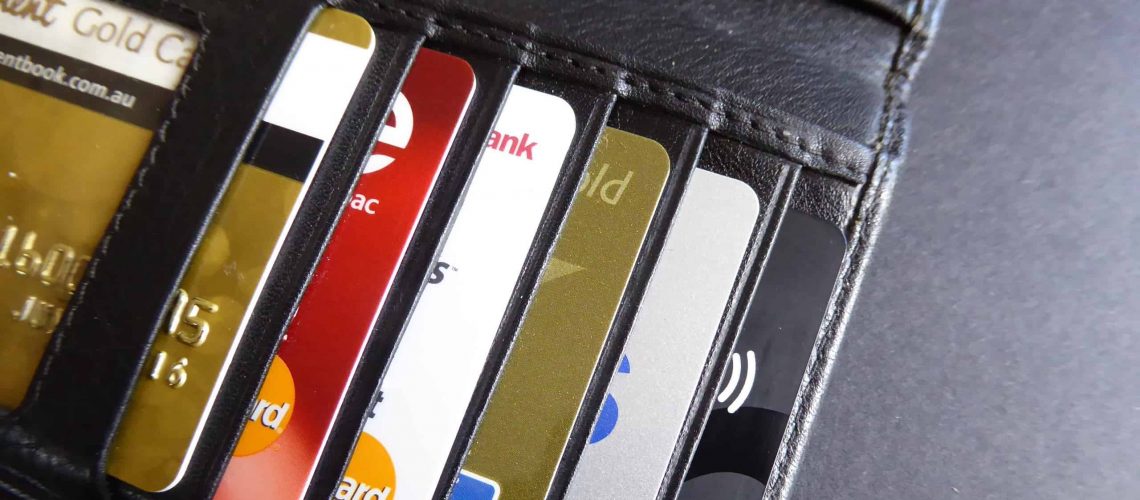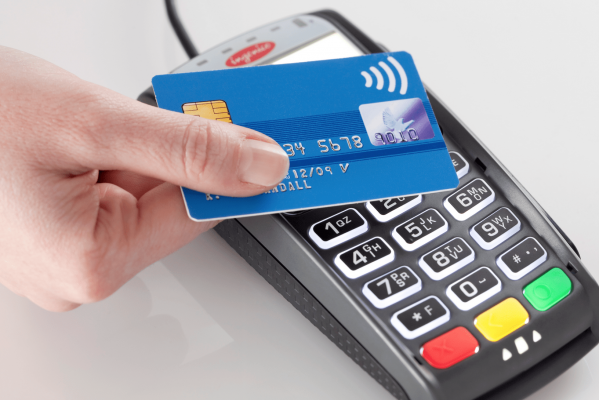- More Baby & Kid
- More Cars
- More Electronics
- More Health & Fitness
- More Hobby & Crafts
- More Home & Garden
- More Other
- More Outdoor
- More Pets
SolidGuides.com may get an affiliate commission when you buy through links on our website. Read More.

If you are in the market for a new wallet, you might notice a new and interesting feature – RFID blocking. A large number of brands now offer a range of different products and accessories to help combat the threat of RFID skimming, or in other words, theft of information from various RFID cards such as credit and debit cards, passports, drivers’ licenses, or government IDs. When you add to that news reports showing how experts easily skim cards, it helps drive demand and raise fears. But is this as big of a concern as some say it is, or a concern at all? Do you need an RFID blocking wallet? To answer, let’s first get a basic grasp of RFID technology.

Example of a contactless credit card payment. Note the symbol in the upper right hand corner of the card.
RFID stands for radio frequency identification, and the technology dates back to the 1960s. An RFID chip with stored information gets pinged by a card reader which has to be near to it, and then that chip quickly transmits data through radio waves. It similar in a way to traditional barcodes, but the chip doesn’t have to be visible to work. The technology is used for pets, livestock, keeping track of inventory, for vehicles, automated road toll and public transit systems, and other familiar things like gates and office key fobs.
More importantly, in the last 10-15 years, RFID chips have also found their way into contactless credit cards. Although they are more widespread in Europe, they’re also present in the US and being offered more and more. All you have to do for a purchase to go through with one is to place your wallet with the card inside on a scanner or tap it, and it will transmit information necessary for payment. There is no need to enter a PIN, or swipe and sign a receipt like most of us are used to.
The advantages are apparent, both in the case of credit cards, and things like passports and driver’s licenses: You don’t have to wait in line as long, whether you’re in a shop or at a border crossing. However, even though it’s convenient, this system may also have vulnerabilities.
The most talked about security issue is RFID skimming which can be performed with readily-available devices that cost less than $100 and even with smart phones.
In a slew of demonstrations, experts have shown how easy it is to get your card number and its expiration date just by placing a reader an inch or two from your wallet, pocket or purse. Even worse, a more sophisticated setup could do this from a distance of three or more feet by using a directional antenna to extend the range of the reader.
Once the card is skimmed, the thief is free to do as he likes with your information. To most people, this sounds like a nightmare situation, but should you really be worried?
In reality, there aren’t any recorded or credible cases of credit card fraud done by RFID skimming, even though you can find anecdotal evidence online like this Reddit post, for example.
Although unlikely, this might have something to do with the fact that skimming would probably be classified under “card-not-present fraud,” a type of credit card scam where a thief doesn’t have to hand over the card itself to make a transaction, think shopping over the phone or online.
However, most stores have security checks put in place to prevent this, so a skimmer would need to have more information than they can read from your card, like the CVV number, and your name.
Furthermore, credit card companies claim newer versions of contactless credit cards – which have been around for more than a few years – don’t transmit sensitive data without encryption anymore such as your name and credit card number.
These new RFID chips now use one-time codes for every purchase, purchases are limited to a smaller amount, and if you go over it, or perform a certain number of payments, you will have to provide a PIN after inserting your card into a PoS (Point of Service) terminal.
This means that an RFID skimmer could, in a worst-case scenario, make one purchase with that code by capturing and replicating it, and he probably wouldn’t be able to steal a significant amount. But, even if you’re misfortunate enough for that to happen, you still wouldn’t be on the hook for the fraudulent charges in most cases.
When it comes to Enhanced Driver’s Licenses (EDL) and American passports, encryption is used as well, so there’s little someone could do. Besides, you often get an RFID-blocking sleeve with your EDL, and most US passports have covers lined with RFID-blocking materials which prevents a closed passport from being scanned in the first place.
Lastly, it’s also useful to put yourself in the shoes of a potential RFID skimmer: doing everything necessary to steal money or personal information this way would be an incredible amount of work and risk for comparably little gain. A much more lucrative option for criminals would be ATM skimmers, hacking or buying hacked credit card information, and phishing e-mails – widespread threats that should be your primary concern and which net them a much large number of cards, more usable information, and in the end more money.
 Like almost any network or technology, an RFID system isn’t foolproof and can be susceptible to different attacks. Besides, the more people use contactless payment the more incentive criminals have to break the security measures put in place to protect consumers. Vulnerabilities may be exposed in the future, even though the risk of RFID skimming seems to be virtually non-existent right now.
Like almost any network or technology, an RFID system isn’t foolproof and can be susceptible to different attacks. Besides, the more people use contactless payment the more incentive criminals have to break the security measures put in place to protect consumers. Vulnerabilities may be exposed in the future, even though the risk of RFID skimming seems to be virtually non-existent right now.
Luckily, the radio waves used in RFID chips and cards are easy to disrupt and block, and that’s what RFID-blocking wallets do. Between materials such as leather, manufacturers sandwich a special layer that makes your wallet skimmer-proof. It’s that simple.
If you want peace of mind – which can be priceless – consider buying an RFID-blocking wallet. It will be worth the bump in price the feature usually demands. You can find attractive, high-quality leather wallets that will look good, last and serve you for years, as well as more budget-conscious options.